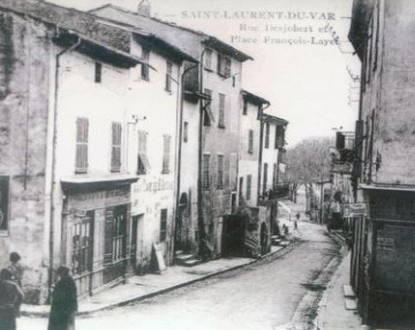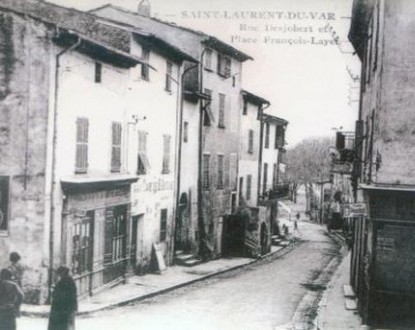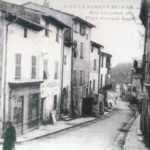Saint Laurent du Var, with its geographical crossroads location on the way to the Var River, has accumulated over time numerous visits from famous figures who have praised its charm, among them well-known writers.
If its delightful Muscat wine was praised at the court of the King of France by Madame de Sévigné, many other authors have noted in their travel diary the merits of this Provençal village, which remained a border until 1860.
On this matter, here is an excerpt from Victor Hugo’s notes where he mentions Saint Laurent du Var during a trip undertaken in 1839 with his friend Juliette Drouet. First impressions of the region when approaching the Côte d’Azur: “Towards Antibes and Nice, the olive tree is a magnificent tree. There it is left to itself, growing as a tall stand. It has an enormous trunk, bizarre and irritated branches, fine and silky foliage that, from a distance, viewed as a tuft, resembles chinchilla fur. It stands dramatically on its hip like a chestnut tree, bearing its branches and fruits with outstretched arms, and offers, like the cedar and the oak, this blend of grace and majesty unique to all trees with a broad trunk and small leaves.” Having reached Saint Laurent on the banks of the Var, the border, Victor Hugo notes in his travel diary: “Var, – fierce and overflowing, long wooden bridge – A red painted shack in the middle of the bridge separates the two kingdoms, hence the tricolor flag that waves among the trees in France at the end of the bridge like a large blue, red, and white flower – in 1830, the inhabitants of Nice flocked to see it, the other month it attracted all the Sardinian post to France, 25 men from the Savoy regiment who left the customs and guardhouse and went to the tricolor flag with weapons and baggage – this nation wants to become French again – Savoy regiment affected by suicides and duels – the soldiers are tired of being Sardinian,” The border guards post, located at the bottom of the current Rue de l’Ancien pont, bordering Parc François Layet, bears on its register the passage of the great man: “No. 6404: Monsieur le Vicomte Hugo aged 36, residing in Paris, with a passport issued for Italy by the Prefect of Police on August 30th is checked at the Var bridge. He returns to Paris with his lady and son on October 4, 1839, it concerns Hugo’s return with the false ‘Madame Hugo’ after his stay in Nice! From this sentimental and family journey as he was accompanied by Juliette Drouet’s son, many vivid impressions gathered will serve to build the framework of future works. Did he not write in 1854 echoing the memories of this journey: “An unforgettable place facing a sea whose every shore has done something and knows what they have done.”
The novelist Gustave Flaubert visits Saint Laurent du Var in 1845 with his sister Caroline recently married to Mr. Hamard. The couple is on their honeymoon to Italy, chaperoned by the family.
Gustave Flaubert notes in his travel diary: “France’s border at the Var: A large bridge, what a difference with the Bidassoa and its Spanish border, so warm, so Spanish already! During the delay for our passports, I read some Vincens in the car searing under the sun in its leathers, left untethered on the main road. Wooden bridge, I finally went to sit in its shade. Lunch: one begins to speak Italian: the ‘Nissarde’ lady with her cape lined in pink, elongated chin, ugly and kind face pitying us greatly. St. Laurent is a humble village corseted by ramparts. Only a few clusters of trees remain from the forest that once covered the Agrimont hill.”
Marcel Pagnol marked his presence in Saint Laurent du Var, as he resided partly in the commune during the Second World War. The Domaine de la Maure, (currently Domaine de l’Etoile) owned by a prominent Nice hardware dealer Philippe Roth, was acquired by Marcel Pagnol in 1943.
The famous Provençal playwright would spend several months there each year.
As a gentleman-farmer, Pagnol cultivated the vine, searched for springs with uncertain fortunes.
Inspired by this land and sensitive to its harsh realities, echoing the long saga of elusive water, this great novelist would write “The Water of the Hills” and “Manon of the Springs” there.
He also wrote his “Memoirs of a Childhood” there.
Surrounded by friends with prestigious names, he would attract illustrious guests like Orson Welles, Tino Rossi, Marcel Achard, the Prince of Monaco, thus spreading the renown of Saint Laurent du Var in the world of arts and letters, as well as that of La Gaude and Cagnes, three communes cutting across his vast property.
https://saintlaurentduvarhistoire.hautetfort.com




